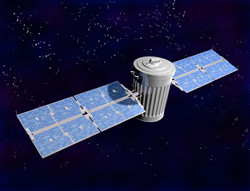Solving the orbital debris problem
More than 500 000 pieces of space debris have been tracked in orbit and their number is steadily rising, making the space environment extremely hazardous. In particular, the low Earth orbit (LEO) (up to 2 000 km from the Earth's surface) is where the majority of imaging satellites are placed to health-check our planet and, therefore, this zone needs to be debris-free. EU-funded researchers proposed a solution that does not require some propellant budget. They developed a passive system that can also provide thrust to the satellite, while generating power for on-board use. The electrodynamic tether developed within the project 'Propellantless deorbiting of space debris by bare electrodynamic tethers' (BETS) could be the answer to the space debris problem. This thin, kilometre-long, conductive tape left bare collects electrons from the ionosphere at its anodic segment and emits electrons through a plasma contactor at the cathodic end. The electric current that flows along the tether produces a drag force through its interaction with the Earth's magnetic field. Electric power can be tapped from the BETS tether for running the cathodic plasma contactor. The BETS de-orbiting system brings together more than 20 years of research on bare tethers and the work of the project partners. During the BETS project, researchers also developed dedicated analysis software to help find the optimum tether design for a given space debris de-orbiting mission. BETsMA provides the tether dimensions, composition and mass, de-orbit time and tether survival probability, among other information. BETS is expected to prevent development of the Kessler syndrome, where colliding debris objects in LEO create a cascade of further collisions, uncontrollably increasing space debris. Avoiding this scenario, one in which the satellites so critical to communications and security would be unable to fly, will benefit industry, governments and the world's citizens.
Keywords
Space debris, space de-orbiting,low Earth orbit, electrodynamic tether, Kessler syndrome







